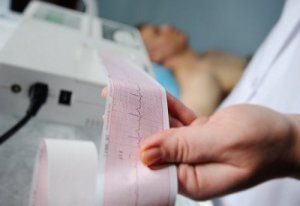Electrocardiogram or EKG: Seven Steps to Interpret It

An electrocardiogram, or EKG, is one of the most frequently used tests, especially in emergency rooms and internal medicine. Interpreting it correctly is decisive in many circumstances. Even though it’s a very common test, its interpretation is not as simple as it may seem at first glance.
The electrical signals of the heart register in the electrocardiogram. Each heartbeat emits an electrical signal that’s recorded by the EKG. Therefore, the test allows medical professionals to visualize heart activity and to detect possible alterations.
In isolation, an electrocardiogram is merely a linear representation. It shows a graph that a cardiologist must interpret. To do so, they must follow a series of steps such as the ones we’re about to describe below.
What to Keep in Mind When Analyzing an Electrocardiogram or EKG

1. Verify the Reliability
The first thing to do is to verify that the electrocardiogram is correct. The EKG must have a speed of 25 mm/s and an amplitude of 1 mV per 10 mm. If you suspect an error, then you must repeat the test.
If everything is fine, then continue to the next step to interpret the data and values you find in this analytical tool.
2. Calculate the Person’s Heart Rate
The heart rate is the most important data that you should extract from an electrocardiogram. Some EKGs calculate it automatically. If not, there are some manual methods to do so. If this isn’t the case, there are manual methods that allow us to do so. Among them, the 300 method, the 1500 method and the 6 seconds method.
Essentially, the heart rate is the number of times a heart contracts to pump blood to the rest of the body. Knowing this can determine if there’s tachycardia or bradycardia, which are important conditions to identify possible anomalies and problems.
Discover: What’s a Myocardial Infarction?
3. Evaluation of the Heart Rate

The heart rate is the sequence of systoles and diastoles in the musculature of the heart. If the organ is normal, it should have contractions about 70 to 75 times per minute. In an electrocardiogram, this is represented in the QRS complexes.
This is one of the easiest data to observe. It allows doctors to determine if the heart rate is regular or irregular. Also whether it’s of normal sinus type or accounts for a sinus tachycardia or sinus brachycardia.
4. Establishment of the Electrical Axis of the Heart
This is one of the most difficult steps in the interpretation of an electrocardiogram. The cardiac electrical axis corresponds to the direction followed by the electrical stimulus as it passes through the ventricles. This data provides information on possible intraventricular conduction defects.
5. Electrocardiogram or EKG: Evaluation of the ST Segment
The QRS complex is the sum of the electrical discharges of all the cells of the ventricles. Then, the T wave represents the repolarization or electrical recovery of the ventricles. The distance between the QRS complex and the T wave is what’s called the ST segment.
Sometimes, the ST segment goes up or down, but if these values aren’t significant, then it’s most likely normal. On the contrary, if the values exceed the minimum range, then the presence of ischemic heart disease is very likely.
You may be interested: Five Ways to Recognize a Heart Attack
6. Evaluation of Waves and Intervals of the Electrocardiogram or EKG

Also, it’s important to perform an analysis of each of the waves and intervals that haven’t been evaluated. The PR interval and the QT interval are particularly important. So, when the PR interval is short, it means there’s accelerated atrioventricular conduction. However, when it’s long, it means the driving has slowed down.
The QT interval represents the duration time of the ventricular electrical systole. In addition, it includes the QRS interval, the ST segment, and the T wave. Also, it’s closely related to heart rate. For this reason, when it’s fast, then the intervals decrease and vice versa.
7. Schematic Synthesis
In conclusion, these are the steps to follow when a doctor interprets an electrocardiogram schematically:
- First, determine a person’s heart rate.
- Next, set the cardiac rhythm.
- Then, define the axis.
- Identify sinus rhythm (presence of Q waves before each QRS complex).
- Then, examine the PR interval.
- In addition, rate the QT interval.
- Evaluate the QSR complexes.
- Then, analyze the ST segment.
- Finally, evaluate the T waves.
Once all these steps have been carried out, the next step is to name the anomaly or anomalies detected. From this it is possible to establish what actions to take. Of course, it is the physician who must interpret an electrocardiogram in order to make the appropriate decisions for each patient.
All cited sources were thoroughly reviewed by our team to ensure their quality, reliability, currency, and validity. The bibliography of this article was considered reliable and of academic or scientific accuracy.
- Hamm, C. W., & Willems, S. (2010). El electrocardiograma: su interpretación práctica; 32 cuadros. Ed. Médica Panamericana.
- Picarzo, J. P. L. (2011). Taller de lectura sistemática del electrocardiograma pediátrico o “cómo interpretar un electrocardiograma y no perecer en el intento.” Pediatria de Atencion Primaria, 13(SUPPL.20), 225–233.
- Sociedad Española de Imagen Cardíaca. Complejo QRS.
- ZÚÑIGA, A. K., GUARDIOLA, G. T., POSADA, M. R., & DEL MAR CASTRO, M. (2018). EL ELECTROCARDIOGRAMA NORMAL. In Electrocardiografía clínica. Modelo de aprendizaje. (pp. 31–47). Editorial Unimagdalena.
This text is provided for informational purposes only and does not replace consultation with a professional. If in doubt, consult your specialist.








